Double heartbreak for both England and Sweden as both teams have been knocked out of contention for the final of the 2019 FIFA Women’s World Cup.
England were defeated by the reigning world champions the USA on Tuesday, 2 July 2019. The match was no short of excitement with both teams exchanging attacks after attacks. However, in the end, England just had to surrender to the latter with the scoreline of 1-2.
Phil Neville’s side were unfortunate as they could have outscored their opposition. Ellen White scored a goal midway through the second half, but the referee ruled it out for offside. The Lionesses then had another chance at goal with a penalty late in the game, but Alyssa Naeher saved Steph Houghton’s shot and held the ball tightly.
Sweden, on the other hand, had to fight until the extra time against the Netherlands. But despite their best efforts, the Dutch ended up being the victors via Jackie Groenen’s marvellous long-range goal in the first half of extra time. Peter Gerhardsson’s side matched Sarina Weigman’s team move for move in their last encounter, frustrating the Dutch with their unbreakable defence. Unfortunately, it was the same case for Sweden as they also couldn’t find a way through to put one past Sari van Veenendaal.
Now on Saturday, both teams will try to forget and leave behind their respective losses and battle again for one last time in the 2019 FIFA Women’s World Cup to see who’ll take the third place in this prestigious competition. In this tactical analysis, we’ll discuss how both teams may set their tactics up on Saturday.
Both teams’ setup – tactical analysis
England
Neville usually rotates his formation between a 4-2-3-1 and a 4-1-4-1 with fluid pivot Jill Scott linking the play, but he might go for a 4-2-3-1 for this match against Sweden. A significant absent for England is centre-back Millie Bright through suspension and she will be replaced by Abbie McManus. Carly Telford started in goal in their last match against the USA, but Karen Bardsley could be the name Neville will choose as these two usually rotates with each other.
Ellen White will continue to be the goal provider for the side, with Nikita Parris and Toni Duggan support her on both flanks. Alex Greenwood is in line to replace Demi Stokes as the left-back has started in most of England’s matches this tournament.
Predicted starting XI (4-2-3-1, from left to right): Bardsley – Greenwood, Houghton, McManus, Bronze – Moore, Scott – Parris, Stanway, Mead – White
Sweden
Gerhardsson tends to set up his team in a 4-2-3-1 system in this competition. He has used the same 4-2-3-1 system throughout the FIFA Women’s World Cup. The only exception was the game against Germany where he deployed his team in a 4-4-2 shape. Yet it was still a hugely similar system – only with Kosovare Asllani being moved slightly forward to play alongside Stina Blackstenius.
There are some worries that Asllani may be out of the team in their third-place game. The creative attacking midfielder suffered what seemed to be a neck injury after an aerial duel with a Dutch player. She was stretchered off the field, but initials scans showed that it didn’t cause serious damage to the player. As of now, Julia Zigiotti may be in contention to replace her in the attacking midfield position. Madelen Janogy and Lina Hurtig could be available as well if Gerhardsson deploys his team in a 4-4-2 shape – with either of the two playing alongside Blackstenius.
Predicted starting XI (4-4-2, right to left): Lindahl – Glas, Fischer, Sembrant, Ericsson – Jakobsson, Rubensson, Seger, Rolfo – Blackstenius, Hurtig
Sweden’s mid-low block
Throughout the FIFA Women’s World Cup we can see that Sweden’s approach to the game was quite flexible. They seemed similar but a bit different game by game. But what we can clearly see is that they tend to defend with a mid-low block and they love to launch counter-attacks with Blackstenius as the target. Now we’re going to leave the latter for later as I’ll explain the former first in this section.
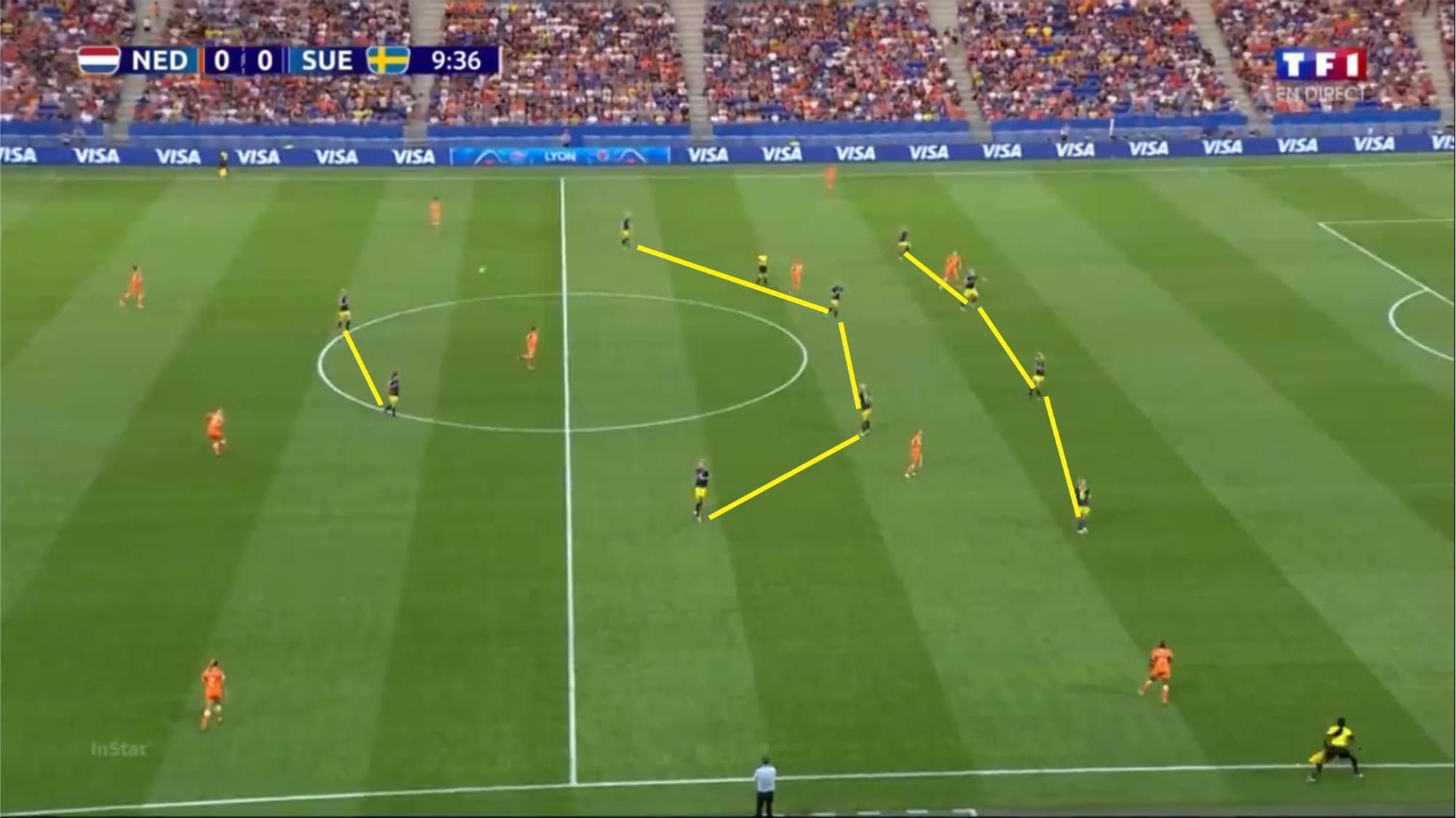
As we can see from the picture, Sweden tend to defend with a mid-low block. Their shape is very compact, allowing almost no gap at all, especially between the midfield and defensive line. However, there is a fairly big gap between the midfield line and the forwards. This is due to the forwards pressing the centre-back. In this particular match, Sweden aimed to mark the passing lane and press centre-back Dominique Bloodworth and defensive midfielder Sherida Spitse, who were both extremely crucial in the Netherlands’ build-up play.
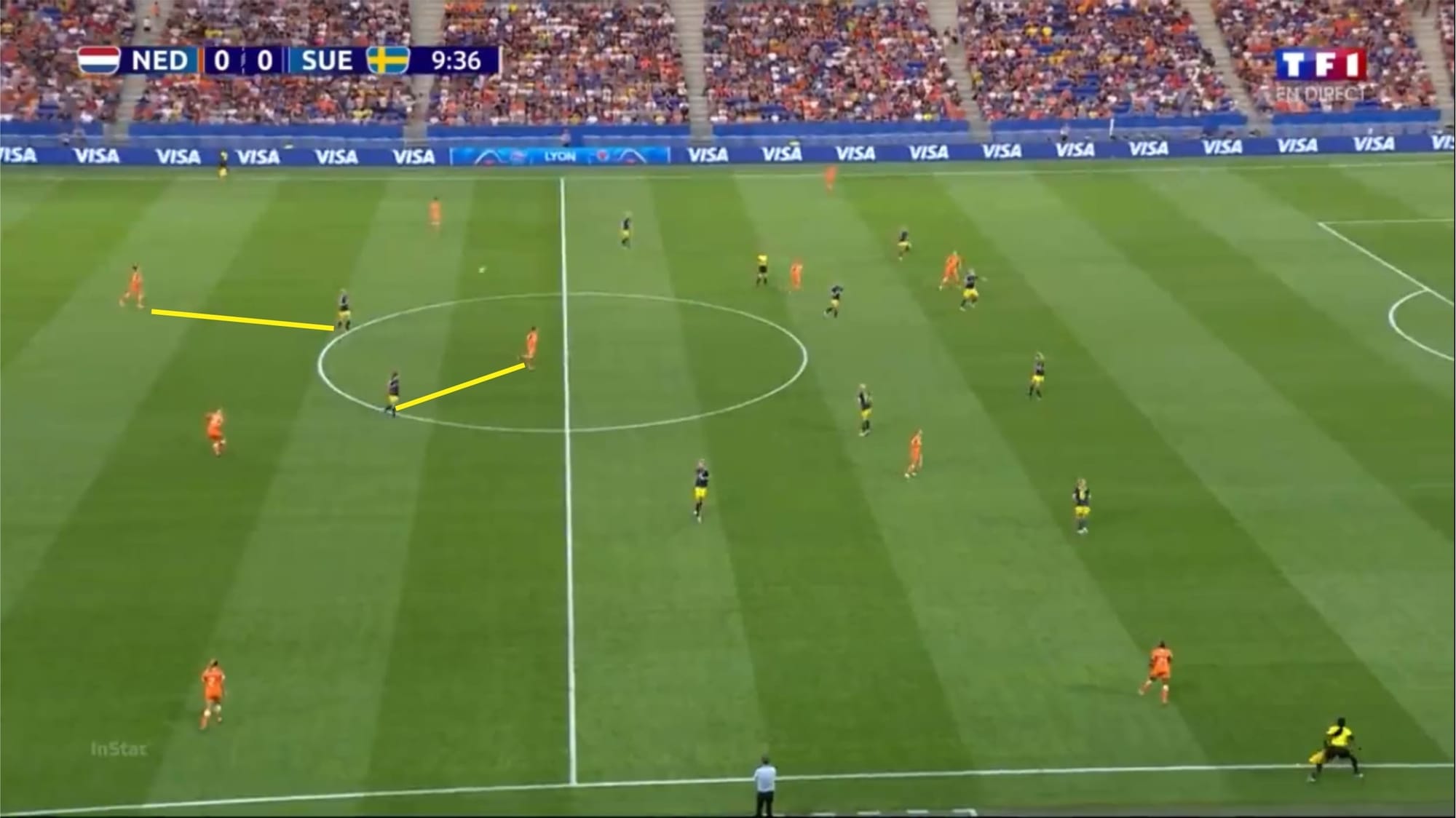
As a result, the Netherlands resorted to progressing the ball via the full-backs or relying on Stefanie van der Gragt who’s less proficient in playing the ball. This strategy was highly effective, but it didn’t stop there.
We can also see from the first picture that Sweden defended in a 4-4-2 shape. With two up front, disrupting the buildup, and a rather low two banks of four basically blocking any path to progress the ball as well as denying any space to be exploited, Sweden are extremely hard to break.
Sweden’s defensive line seems to be fairly wide, while their midfield line was quite narrow with the two wingers dropping deep and tucking themselves in. This compressed the space in the middle, not allowing the opposing team to play any pass to a player between the midfield and defensive line. This could be a problem for England as they seemed to be a team that often play through the middle and breakthrough centrally.
Despite all that, overloading the middle means that there will be some space left in wider areas. Let’s take a look at the picture below.
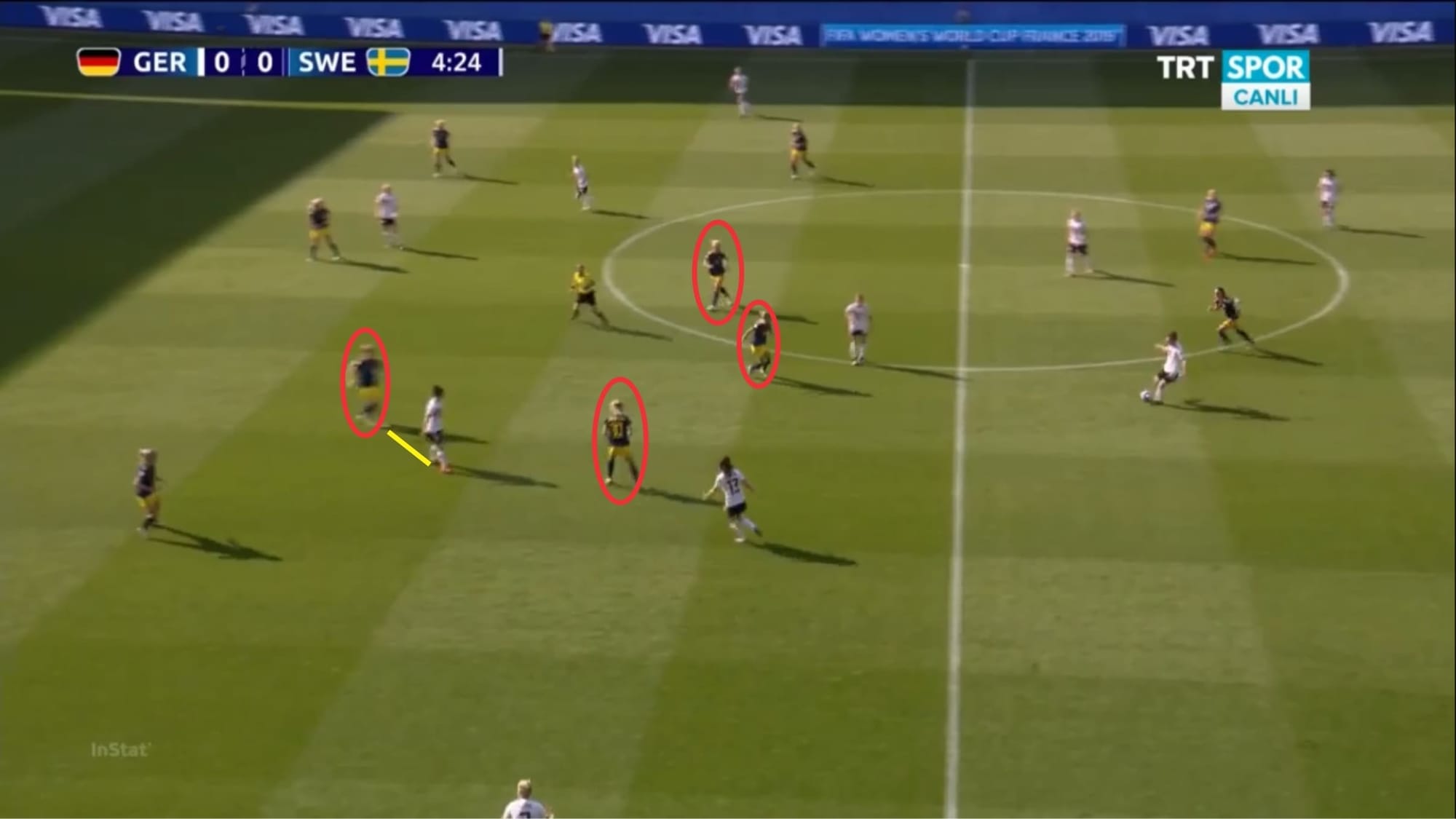
As mentioned earlier, Sweden refuse to allow any pass between the lines with the centre-back pushing forward and marking the German forward while the midfield line moved even narrower. But this opens up some space out wide which can be exploited by the opposing team.
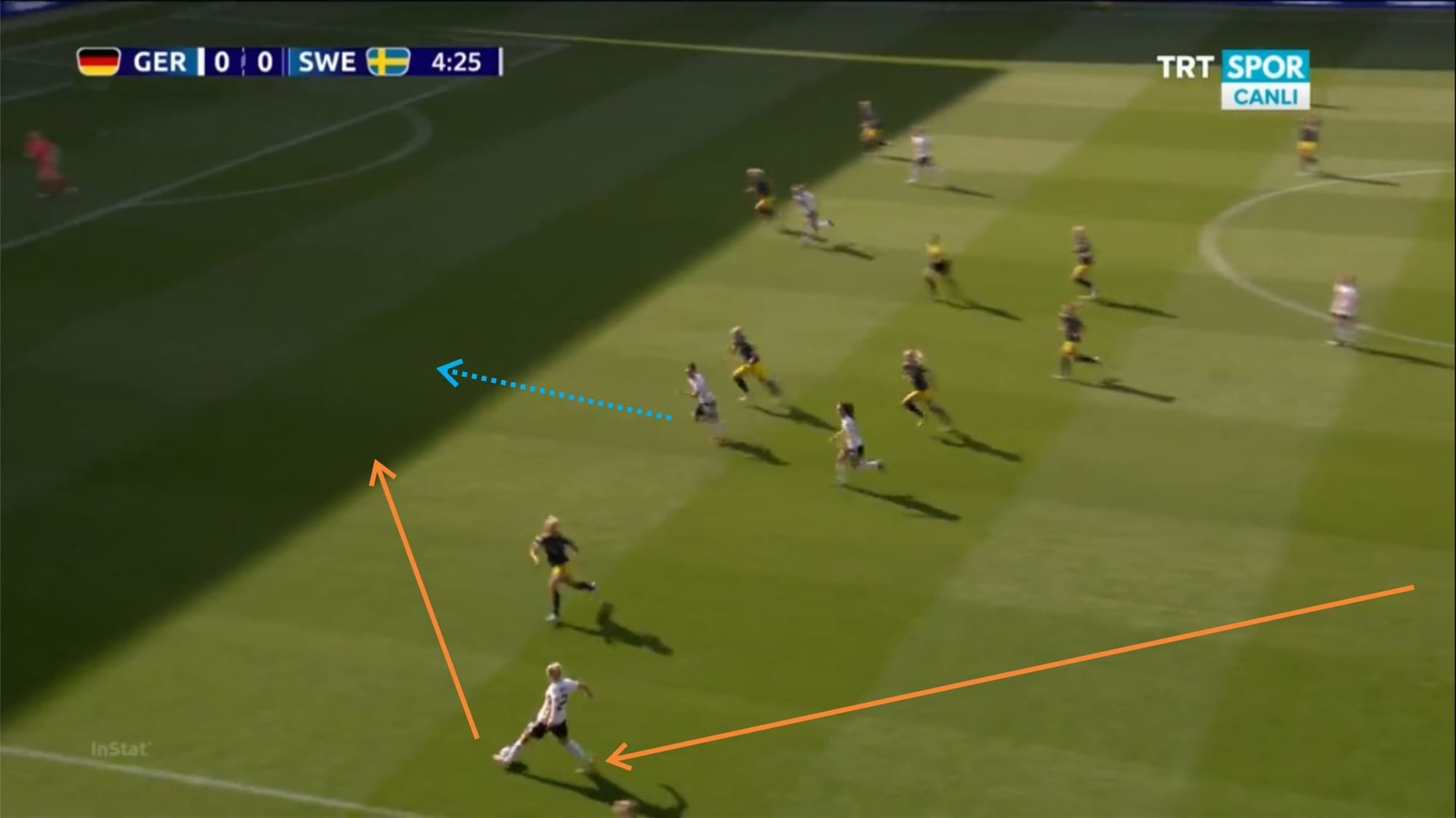
After receiving a pass from Marina Hegering – Carolin Simon, who sat high up the pitch, could have conveyed the ball onto the path of Lina Magull, who’s already in her stride after previously dragging Nilla Fischer out of position. Although at that time, Simon chose to cut inside instead and gave the ball to the German centre-mid, which slowed their attack a little bit, allowing Sweden some time to recover.
Sweden are very disciplined and very quick when transitioning both from defence to attack and vice versa. If England really want to hit Sweden on the counter, they need to be really quick, with no delay at all in play. Or else, the Swedish players will eventually catch up and pretty much cancel their attempt in a counter-attack. This was apparent from their match against the Netherlands as we can see from the picture below.
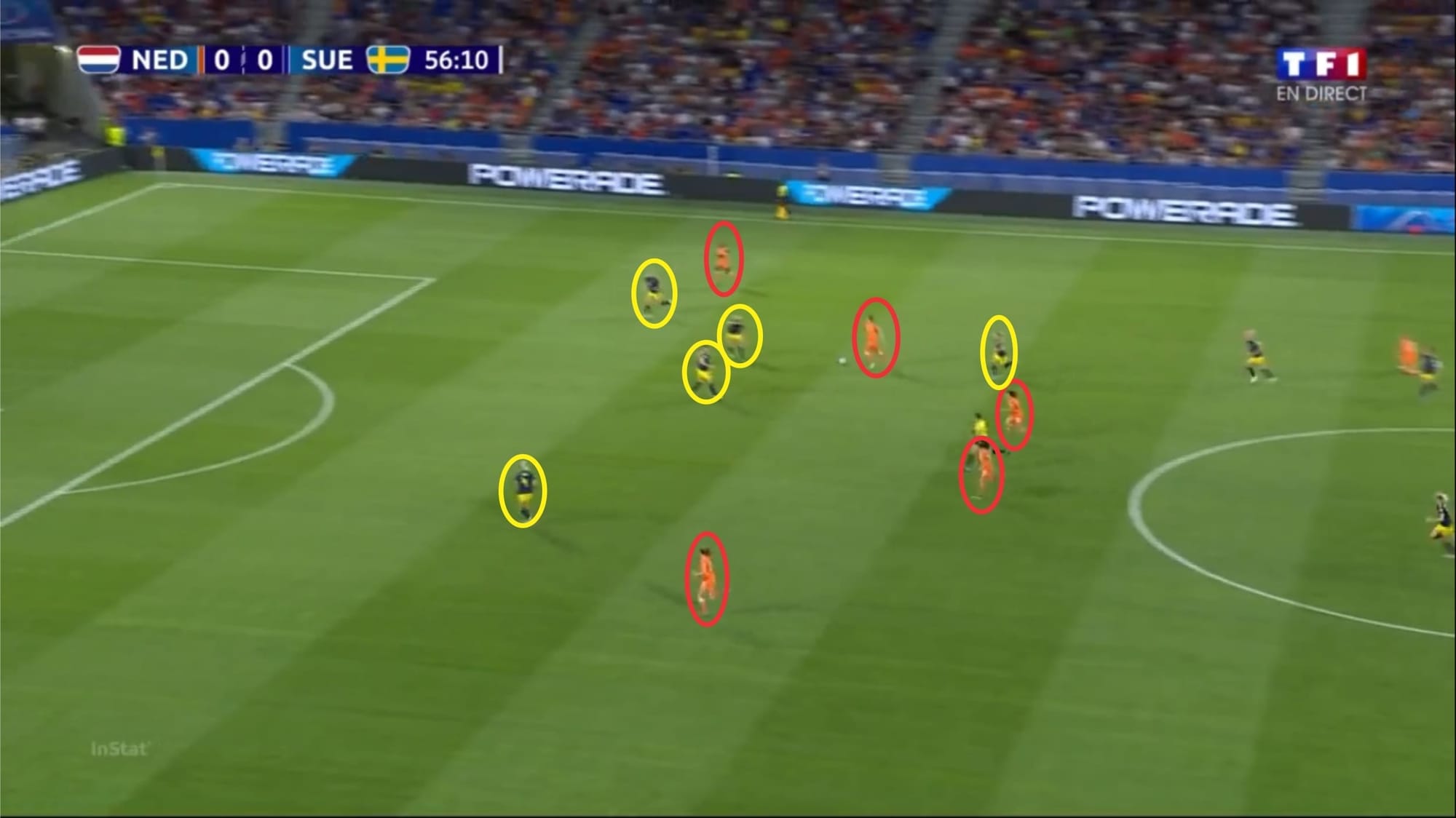
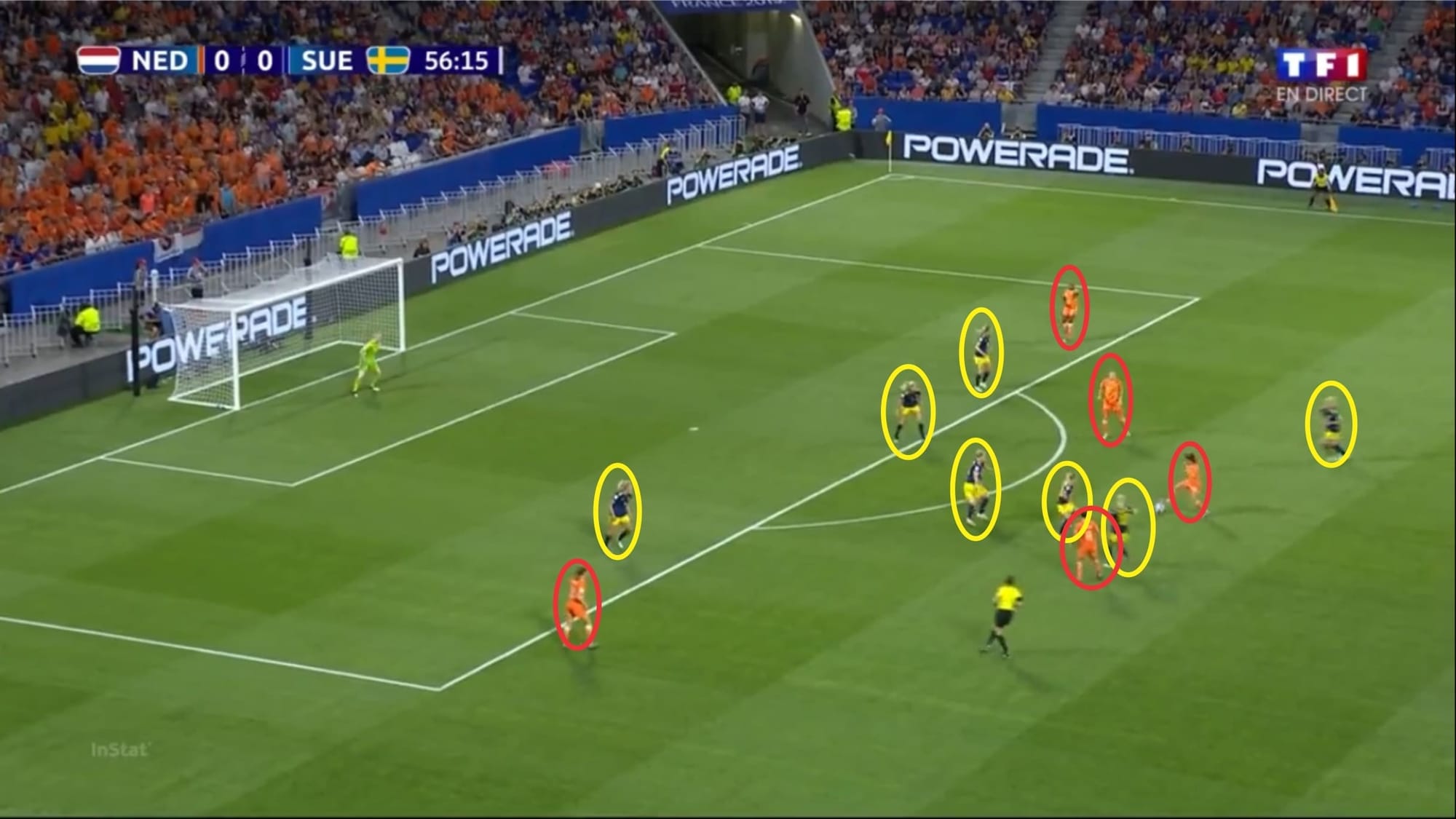
The picture above shows the Netherlands regaining possession and immediately launching a counter. The Dutch have more players on the front foot, while Sweden have four ready to defend, with another trailing not far behind. In this situation though, the Dutch were a bit too slow in making their decisions. This slowed them down considerably and gave them time for the Swedish players to get back to defend. The Dutch attacker also didn’t seem to receive any support from the teammates in this case.
England, as we have seen so far throughout the FIFA Women’s World Cup, play with two offensive full-backs who sit high and always ready to maraud forward. Both may come in handy against Sweden if Neville can use them smartly.
In England’s case, they usually play with one striker up front, unlike Germany that played with two in this game. Neville usually deploys his side in a 4-3-3 or 4-2-3-1 system, but I believe this could still work.
In 4-2-3-1, the attacking midfielder should be the one that drags out the centre-back while the winger sits narrower while getting ready to exploit the space left by the defender. Full-back should sit high. With the rather large space allowed by Sweden on the flanks, the full-back should have enough time to control the ball and release it forward before receiving pressure from Sweden.
In 4-3-3, this may also work, but needs a bit flexibility in terms of positioning and movements. The right/left centre-mid can advance forward, attracting one of the centre-backs. Meanwhile, the full-back sits high and the winger stays narrower. This forms a 2-4-4 shape with two centre-backs holding their position, two full-backs out wide, a defensive midfielder and a central midfielder as the double pivot in the middle, two wingers that sit narrow, a central midfielder that marauds forward sitting alongside the main striker.
Of course, there’s also a chance of this not happening. Especially if the centre-back refuses to follow the attacker and the full-back stays in position and doesn’t press the full-back.
Will Sweden pull a surprise in the attack?
Sweden tend to press aggressively in their own half. They allow the opposing team to play the ball laterally at the back but don’t give them much chance to move it vertically. Again, this is due to their compact mid-low block. If the opposing team managed to move vertically and enter their half, Sweden will start pressing. This is why they allowed around eight passes per defensive action per game on average. Sweden also averaged around 70 ball recoveries in their own half per game as well as around 16 counter-attacks per game.
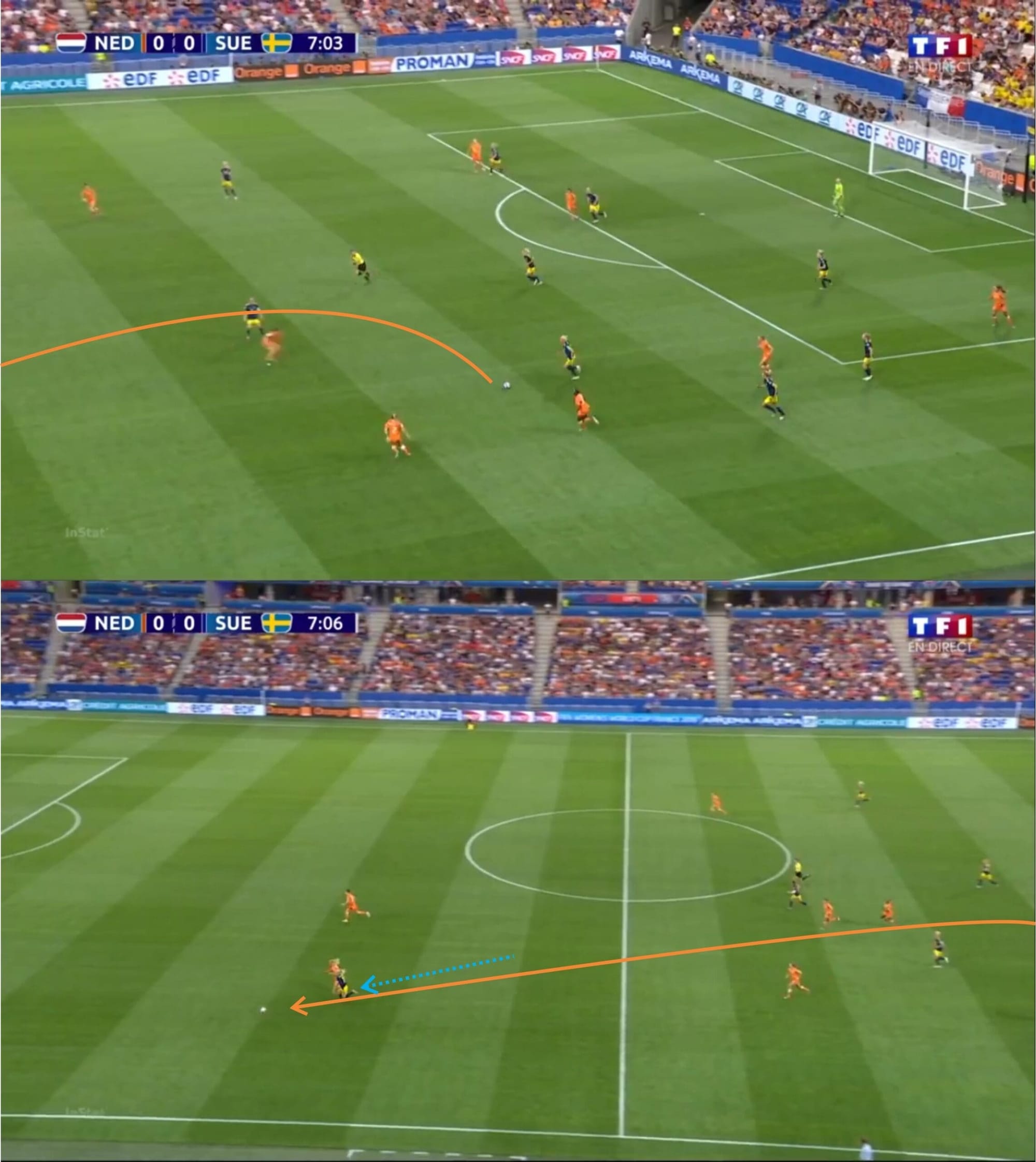
After winning the ball deep in their half, Sweden will try to launch a quick counter-attack with Blackstenius as the counter target. The 23-year-old striker is both pacy and powerful. To add to that, she also has excellent spatial awareness, as apparent with her excellent positioning and off the ball movements. Blackstenius also has very good ball control which means that she won’t have much trouble beating the opposing team’s defender once she gets on the ball. The young striker has the perfect blend of tactical intelligence, technical proficiency, and physical advantage that makes her the perfect target for counter-attacks.
In counter-attacks, Sweden tend to try to break through centrally. Due to mostly winning the ball deep in their own half, they need to use long balls into space to reach Blackstenius who’s waiting up front.
In positional attacks, Sweden usually tried to play through the middle. They seem to try to play out from the back with the view of progressing forward fairly quickly. They tend to exchange straightforward, short-medium range vertical passes. Sweden seem to try to deliver passes to players standing between the opposing midfield and defensive line, through the gap between their midfielders. As shown in the picture below.
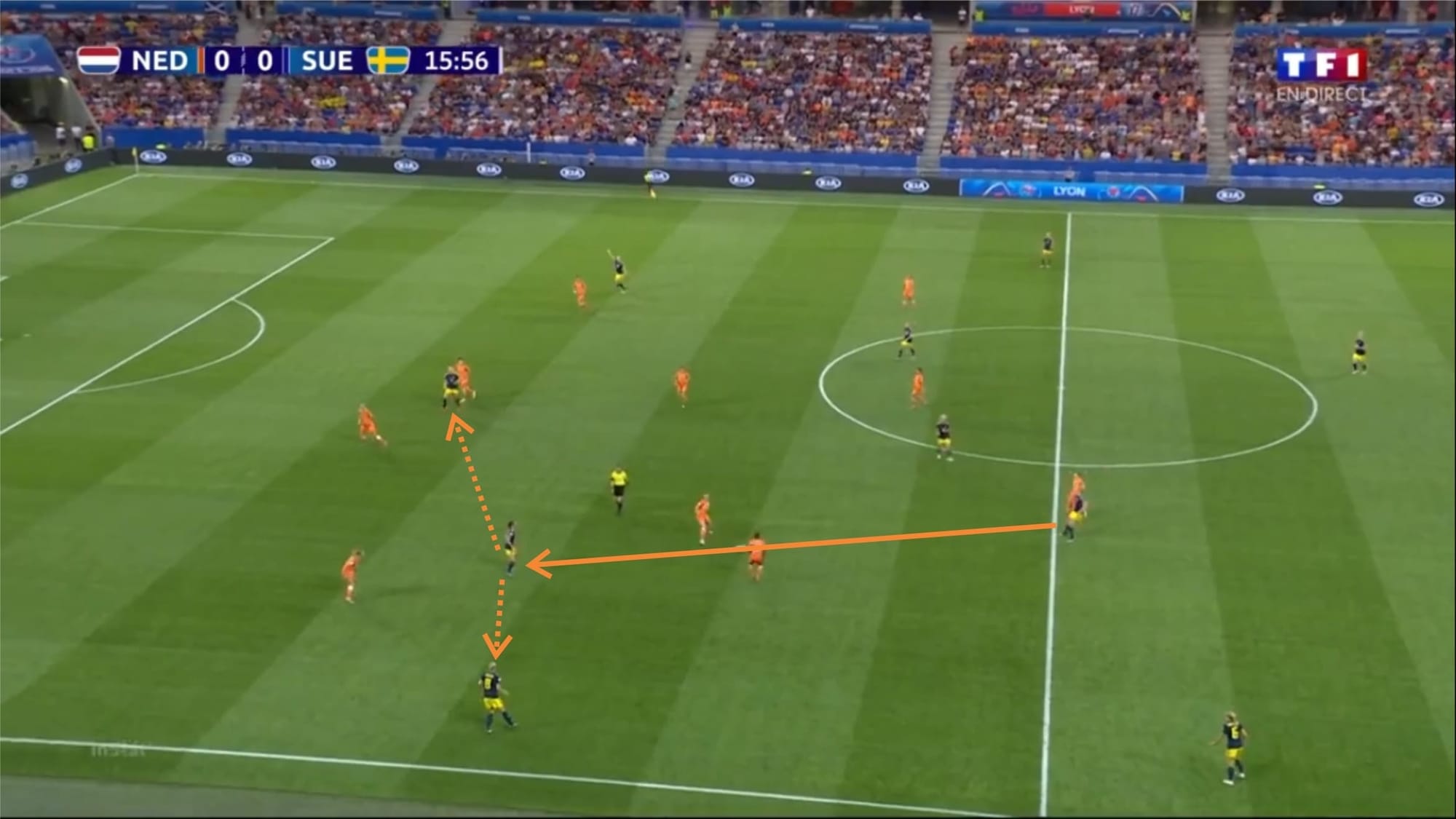
Asllani tends to position herself in pockets of space. In this picture, after receiving the ball from Linda Sembrant, Asllani has the freedom to play her passes. She could play it onto the feet of Blackstenius, but the striker was under pressure. She could also chip it through to the striker. In this situation though, Asllani chose to combine with Lina Hurtig. The latter then found herself in a good position to cross in the byline but failed to deliver a proper one.
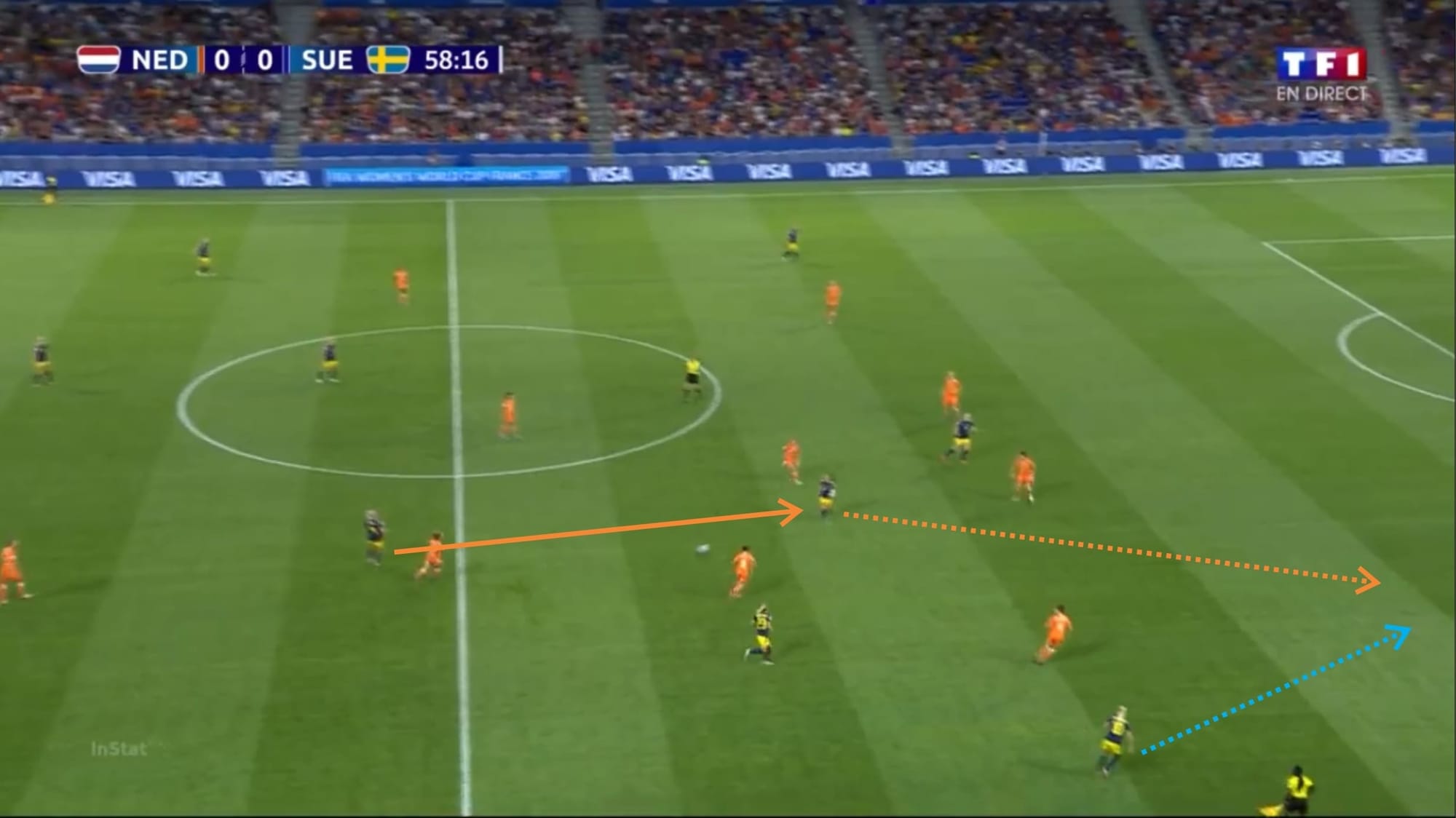
Unlike their counter-attacks, Sweden’s positional attacks usually come from wider areas although their build-up play is often focused in central areas. Again in the picture, Asllani was found in a pocket of space. She then passed the ball onto the path of Sofia Jakobsson who freed herself of her marker on the right flank.
Sweden’s wingers usually prefer to hug the touchline and deliver crosses rather than cut inside.
What should Sweden do to break England’s defence?
England’s build-up and wing attacks
Neville’s side has the tendency of building their attacks from the back. Usually, Keira Walsh would drop deep and create passing triangles with the defenders inside their own half. Houghton, a ball-playing defender, and Bright split each other while still maintaining a sufficient distance in order to create low-risk passes. The full-backs could also tuck in to create a narrow build-up block. This allows them to circulate the ball more fluent and stretches the opposition’s defensive structure to create spaces between channels.
Against a Sweden side that usually defend deep, England defenders will have the chance to play out from their defence. They can also recycle possession and be more precise in their penetrative passes which will act as the key method to start their attacks.
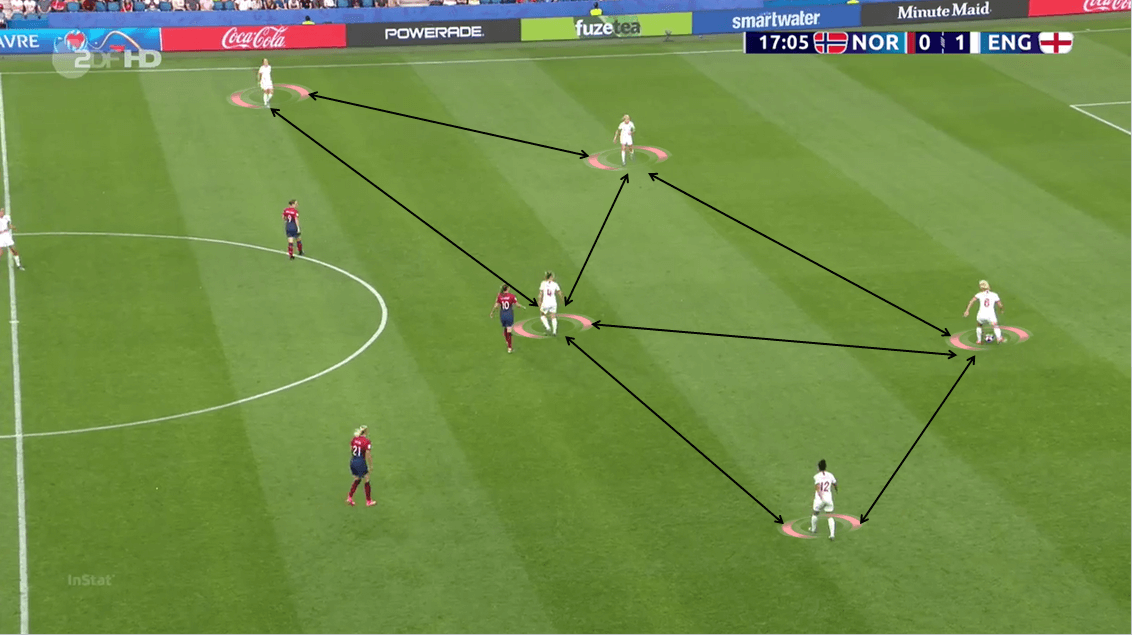
Another option for Stokes and Bronze is to locate themselves high up the pitch and not participate in the build-up. By doing so, England would create a 2-4-1-3 formation with Kirby playing between the midfielders and the strikers. The wingers will tuck inside, dragging the opposition’s defensive line into the central area. It creates spaces on both flanks for the full-backs to overlap and provide support in the transition.
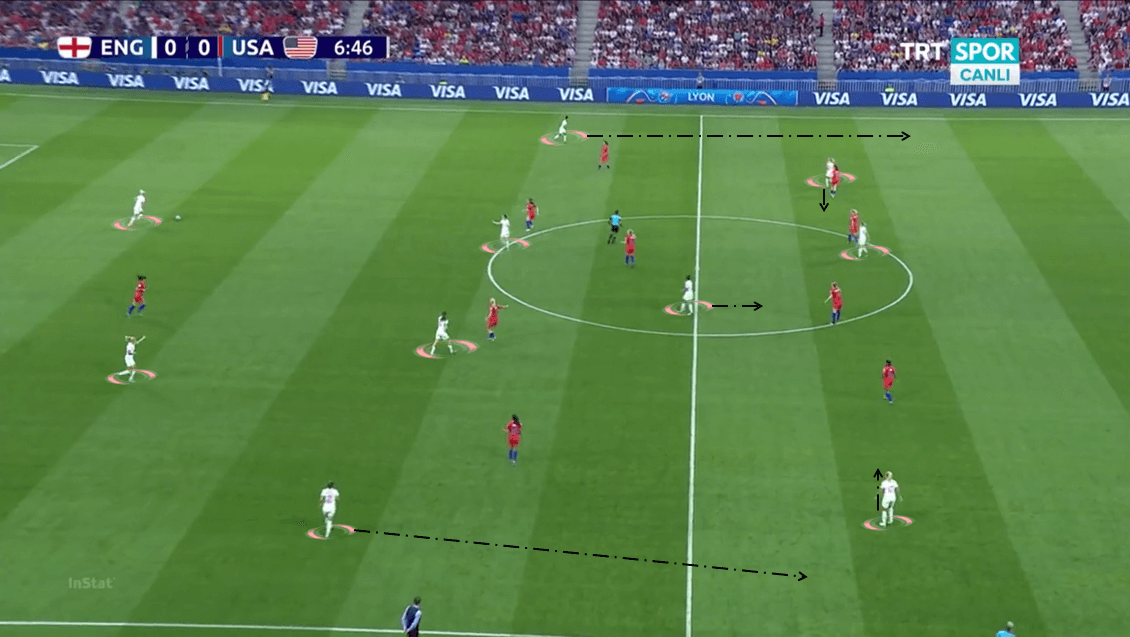
After moving the ball into the opposition’s half, they will focus their attacks to both flanks, especially on the right-hand side. Using her positional awareness, Lucy Bronze will occasionally make overlaps into the wide areas and drag the opposition’s full-back out wide. She creates spaces for Parris to cut inside and threaten the goal.
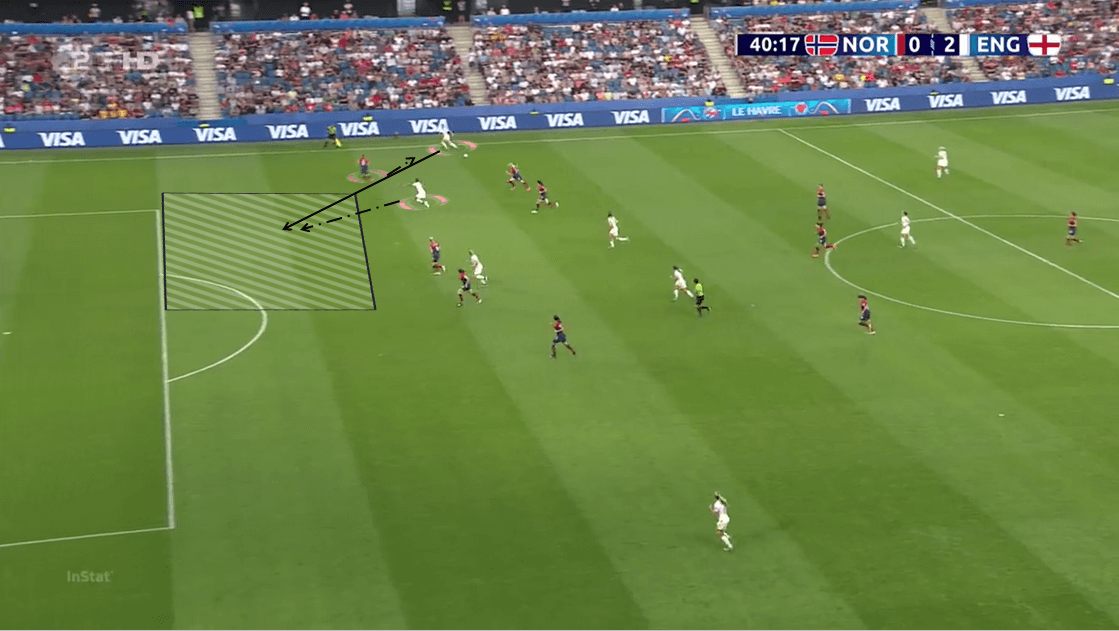
Parris’ run would drag the opposition’s defensive line into their own box, allowing the late arrivals to become a passing option. In this shot below, Norway defenders were attracted to Parris and so was Engen. This allowed Kirby and White to arrive in the box and receive the pass from the right-winger.
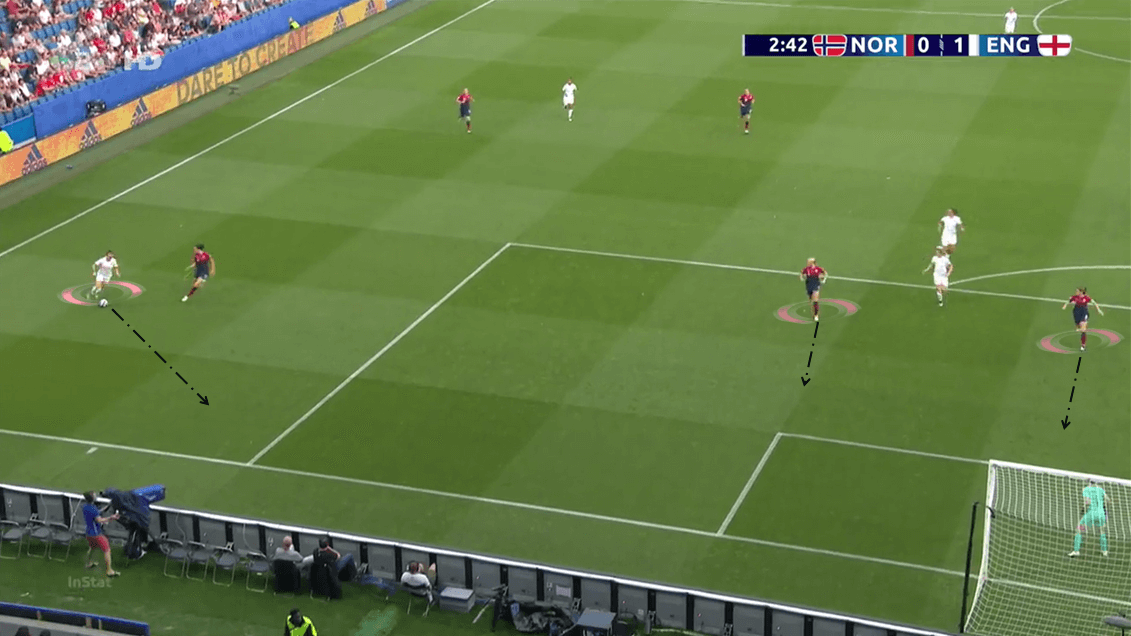
England used this attacking strategy efficiently in the competition, which demonstrated through their accurate passing percentage (83%). But they also showed signs of struggle when playing against a high-pressing team. In the shot below, the USA used a 3-3-4 formation to intrigue the press. With four players on the front line, they pinned England’s defenders inside the 16-yard box. Also, Ellis’ side played with a narrow formation that allowed them to create overloads in a certain area and recovered the ball easily.
Both Scott and Walsh dropped into the spaces to provide passing options. But they weren’t available for England’s ball carrier as they were in the USA’s players sight. This forced her to make a risky option, which was to play a long ball into the opposite half and wait for a teammate to pick up.
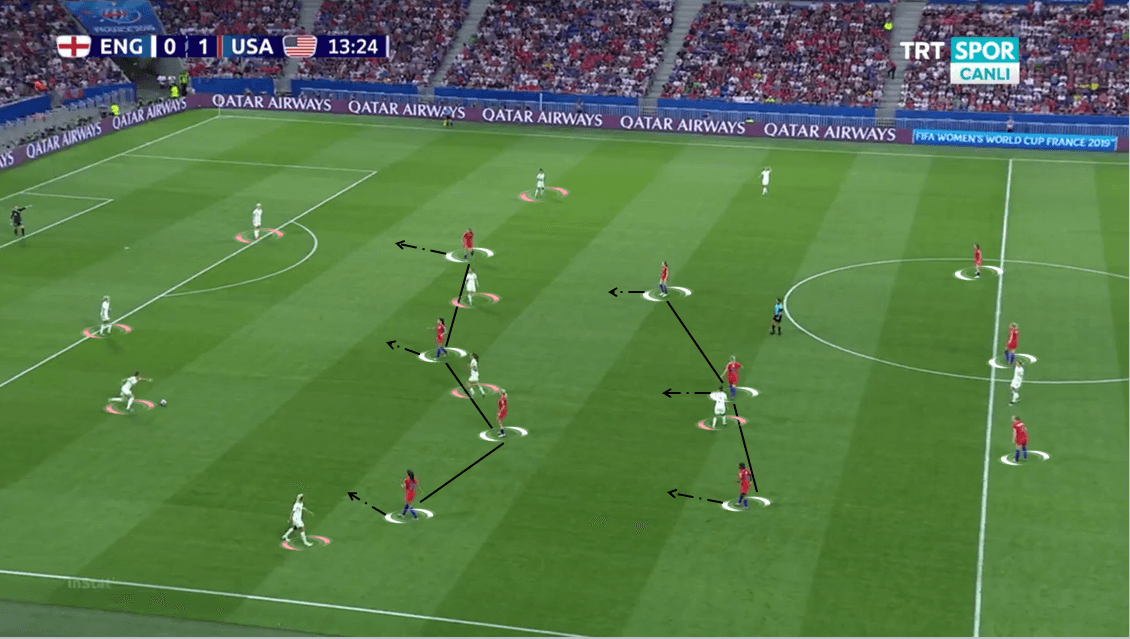
A solid 4-4-1-1 provides solidity in defence and transition
England aggressively press the opponent inside their own half using a 4-4-1-1 formation. White and Kirby are flexible players who usually roam from their position to interrupt the opposition’s build-up. Meanwhile, the midfield line locates themselves near the halfway line and responsible for intercepting any passes heading into the middle third.
If they manage to recover possession high up the pitch, there would be enough players for them to start a counter-attack and even overload the final third.
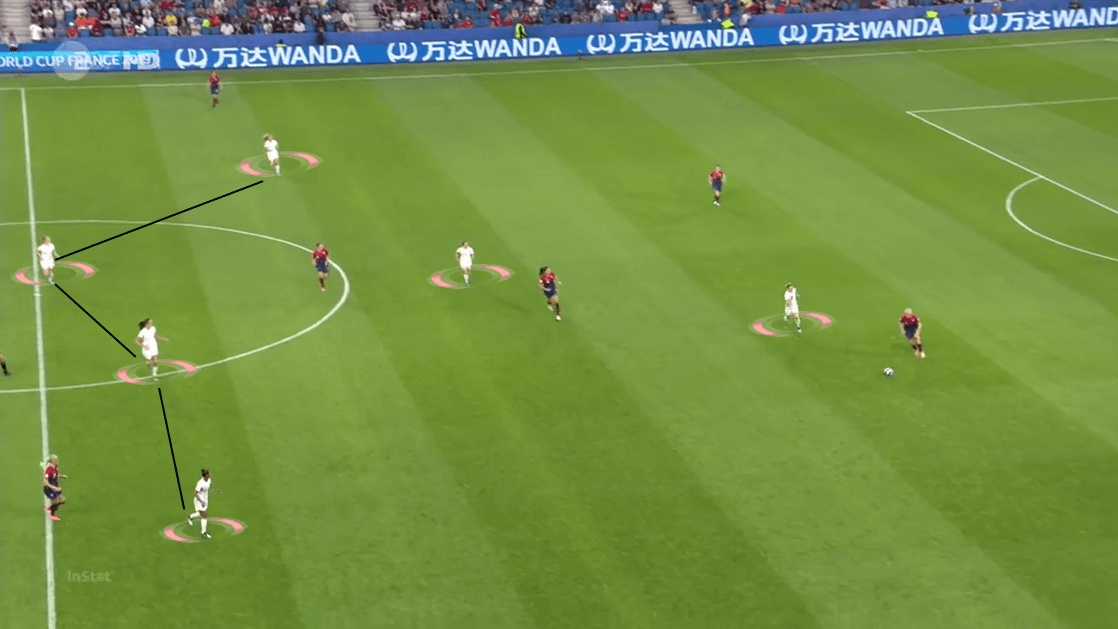
Their 4-4-1-1 defensive structure needs to be aware of Sweden’s counter-attacks. They will try to play between the lines using short and quick one-twos while Blackstenius’ positional awareness and off-the-ball intelligent will be the key for them.
With two narrow and disciplined defensive lines, it is possible to stop the striker’s influence on the field by marking her tightly. If one player decides to step out, the attacking midfielder will move down and cover that vacant spot. This defensive structure kept the USA struggled for a few moments in the game, combined with the high pressure they applied, it was hard for Morgan and co. to reach Telford’s goal. Unless they maintain their high level of concentration and discipline, it will be hard for Sweden to break the structure down.
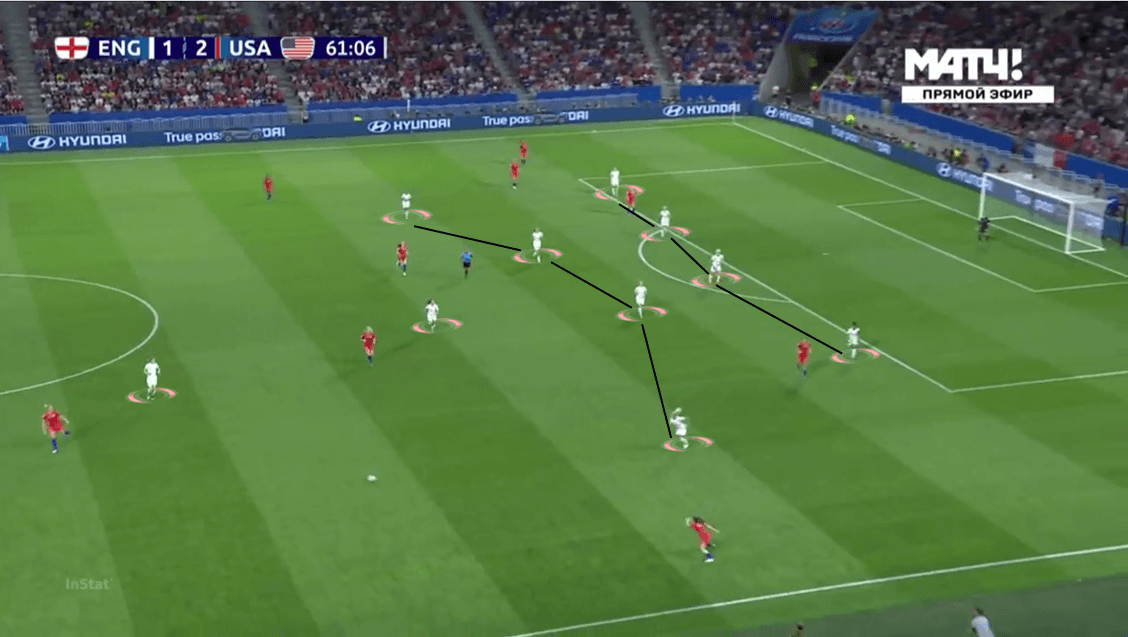
Conclusion
Both England and Sweden didn’t enjoy much luck in their semi-finals matches as they lost out to the contenders. But their journey won’t end there, as they will both battle it out for the third-place spot in Nice. This tactical analysis has helped you understand how will both teams play and counter each others’ tactics. The attractive style of play that Phil Neville and Peter Gerhardsson has used throughout the tournament will contribute to what considered as a thrilling clash at the Allianz Riviera.
If you love tactical analysis, then you’ll love the digital magazines from totalfootballanalysis.com – a guaranteed 100+ pages of pure tactical analysis covering topics from the Premier League, Serie A, La Liga, Bundesliga and many, many more. Buy your copy of the June issue for just ₤4.99 here, or even better sign up for a ₤50 annual membership (12 monthly issues plus the annual review) right here.

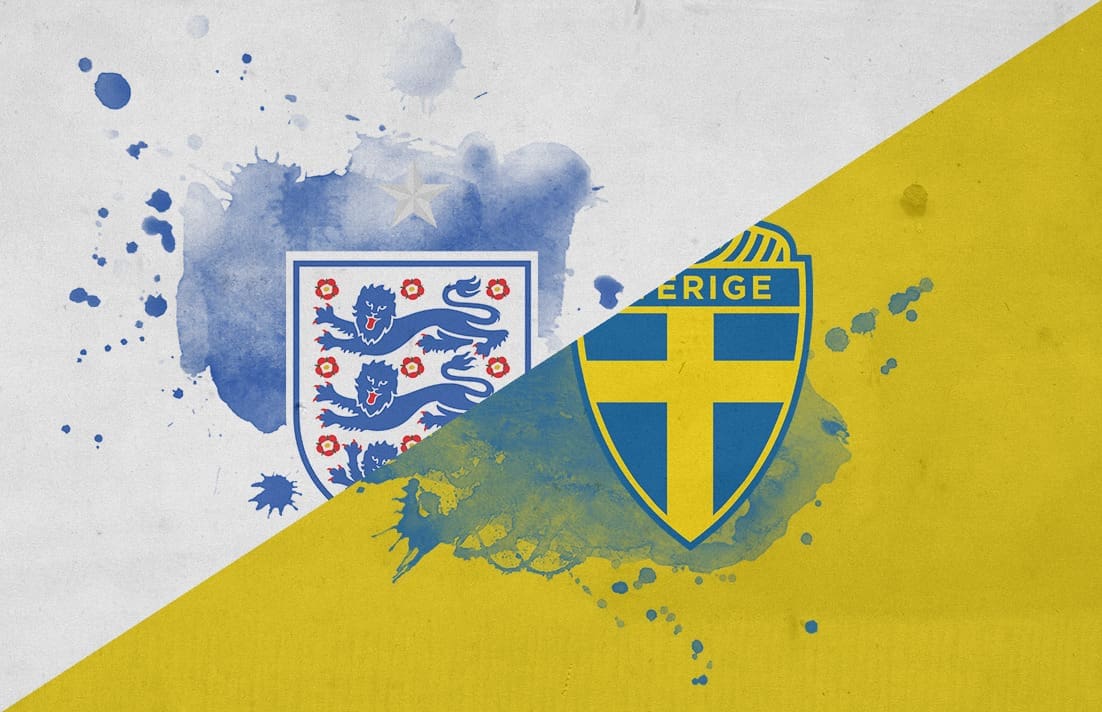



Comments